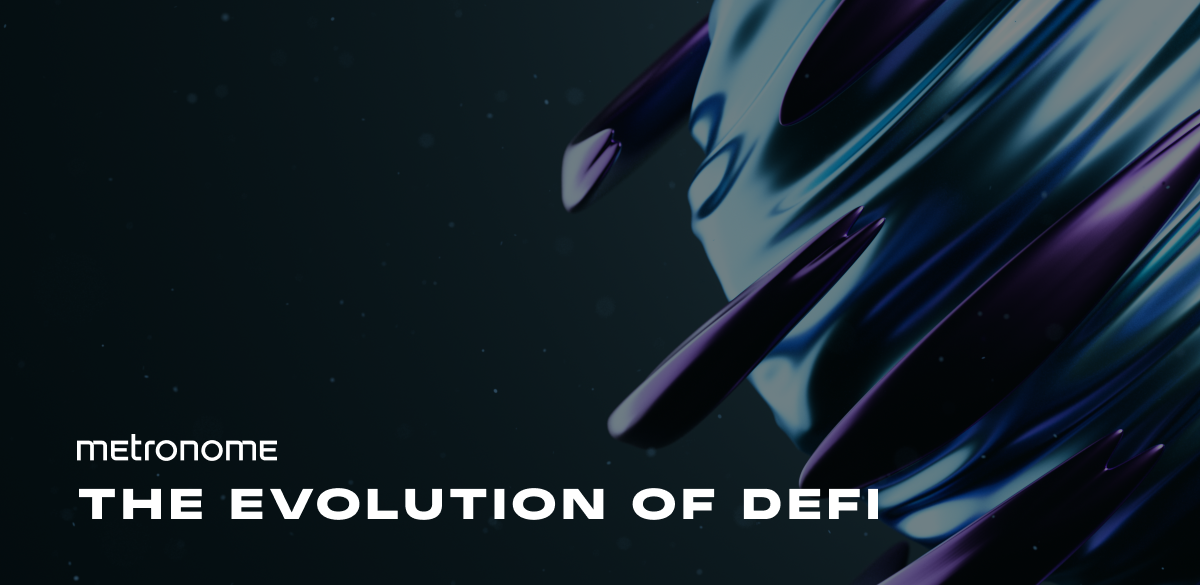Decentralized Finance, often referred to as DeFi, was created to eliminate the need for centralized intermediaries. With the foundation already established through Bitcoin’s design, Ethereum was able to enter the ecosystem and provide the required architecture needed for true decentralization.
The Evolution of DeFi
The evolution of DeFi didn’t just happen overnight, it took place in multiple waves. For this to occur, projects needed to carefully identify gaps in the market and create solutions that were easy to use while also incorporating the functionality of centralized resources.
This in turn sparked a rush of users to DeFi which changed how the typical onboarding process operated. Previously, users would visit exchanges with fiat currency and trade/hold digital assets on centralized entities. However, as the DeFi momentum started to pick up, there was no longer a generalized consensus that keeping tokens on centralized exchanges would give long term value. Instead, users opted to deposit their tokens directly into self-custodial wallets such as MetaMask. The foundations for a fully decentralized ecosystem were being formed.
Once the potential for decentralization was realized, DeFi applications (dApps) flooded in that solved real-world problems. Suddenly, users could transact, borrow, earn, save, and much more all through these dApps. This caused a rapid influx of users to not only start using dApps, but also help in their evolution by building applications that were inherently interoperable.
DeFi Milestones
The first major DeFi milestone was in 2017 when both Bancor and MakerDAO came to fruition. Users were able to mint DAI stablecoins with collateralized debt positions using ETH by utilizing MakerDAO. The user could later repay the DAI in order to be returned their ETH deposit. This new mechanism of creating collateralized debt was the first of its kind within the ecosystem. When Bancor hit the scene, users were able to experience a new style of exchange referred to as a DEX; after previously relying on an intermediary such as EtherDelta. The Bancor protocol introduced Automated Market Makers (AMM), which defined the liquidity provider role and shared fees with those who provided liquidity. These novel ideas at the time have become important tenets of the DeFi ecosystem we know and exist in today; and ultimately lead to the next stage of DeFi fundamentals: borrowing.
Early 2018 brought the inception of Compound to the DeFi space: Compound enabled users to borrow and lend various assets in a permissionless, and autonomous protocol. The highlight of Compound protocol was the real-time interest rate determination for borrowers and lenders that allowed interest rates to change based on the demand for the underlying asset. Later, platforms such as AAVE were developed. Their process was simple, lenders who provided liquidity would earn rewards based on their contribution, whilst borrowers would receive loans at lower interest rates than TradFi with the ability to over-collateralize. Following was the creation of Uniswap — a protocol which took the DEX experience to the next level with deep liquidity functionality and an inclusive AMM setting the gold standard for “swaps” on-chain.
DeFi has since helped continue the decentralization rationale of crypto and lowered barriers to entry for entirely new audiences through a multitude of advancements on these principles. There is no minimum deposit to self-custodial wallets, and yield on DeFi protocols generally doesn’t discriminate between deposit amounts.
Now, with decentralized assets in users’ control and the ability to deploy them to decentralized finance protocols at will — the value of the space has increased significantly. The next logical step is to bring centralized provisions to a now-decentralized financial space.
And with the wound still fresh from the fallout of Celsius, 3AC, FTX, and many others, it is especially important to note the significance of DeFi and how the non-custodial aspects of web3 can help keep user funds safe while not limiting their potential use case scenarios.
Synthetic Advancements
More recently protocols have seen the progression of “synths”, which enable users to acquire assets that may have previously been unobtainable. This is made possible through decentralized oracles which track the value of the underlying asset and peg it to its synthetic parallel. The end result is a synthetic asset that stands 1:1 with its counterpart. In Metronomes’ case, users will be able to achieve capital efficiency while utilizing the best features from market leaders, all within a single protocol.
Metronome Synth Summary
Metronome Synth is a new multi-collateral/multi-synthetic protocol enabling users to stake collateral, including productive collateral, from their existing crypto holdings to create synthetic versions of other popular crypto assets. Users will continue their Metronome journey in the Metronome marketplace where they can swap between synthetic assets with zero slippage. The Metronome Synth protocol is powered by the MET token, which can be used as collateral and also acts as the governance token for the MET DAO.
Like what you read?
Consider joining our Discord community or follow us on Twitter to stay up to date with everything Metronome, we have many more exciting announcements to come soon.
